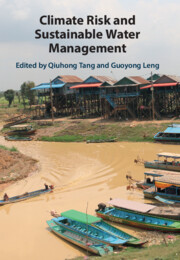Book contents
- Climate Risk and Sustainable Water Management
- Climate Risk and Sustainable Water Management
- Copyright page
- Contents
- Contributors
- Preface
- Acknowledgements
- Part I Water-Related Risks under Climate Change
- Part II Climate Risk to Human and Natural Systems
- 7 Observed Urban Effects on Temperature and Precipitation in Southeast China
- 8 Vegetation Dynamics, Land Use and Ecological Risk in Response to NDVI and Climate Change in Nepal
- 9 Climate Warming Induced Frozen Soil Changes and the Corresponding Environmental Effect on the Tibetan Plateau
- 10 A Review of the Effects of Climate Extremes on Agriculture Production
- 11 Agricultural Water Use Estimation and Impact Assessment on the Water System in China
- 12 Impact of Inter-Basin Water Transfer on Water Scarcity in Water-Receiving Area under Global Warming
- 13 Broadening and Deepening the Rainfall-Induced Landslide Detection
- 14 Estimating Aquifer Depth in Arid and Semi-arid Watersheds using Statistical Modelling of Spectral MODIS Products
- Part III Sustainable Water Management under Future Uncertainty
- Index
- References
14 - Estimating Aquifer Depth in Arid and Semi-arid Watersheds using Statistical Modelling of Spectral MODIS Products
from Part II - Climate Risk to Human and Natural Systems
Published online by Cambridge University Press: 17 March 2022
- Climate Risk and Sustainable Water Management
- Climate Risk and Sustainable Water Management
- Copyright page
- Contents
- Contributors
- Preface
- Acknowledgements
- Part I Water-Related Risks under Climate Change
- Part II Climate Risk to Human and Natural Systems
- 7 Observed Urban Effects on Temperature and Precipitation in Southeast China
- 8 Vegetation Dynamics, Land Use and Ecological Risk in Response to NDVI and Climate Change in Nepal
- 9 Climate Warming Induced Frozen Soil Changes and the Corresponding Environmental Effect on the Tibetan Plateau
- 10 A Review of the Effects of Climate Extremes on Agriculture Production
- 11 Agricultural Water Use Estimation and Impact Assessment on the Water System in China
- 12 Impact of Inter-Basin Water Transfer on Water Scarcity in Water-Receiving Area under Global Warming
- 13 Broadening and Deepening the Rainfall-Induced Landslide Detection
- 14 Estimating Aquifer Depth in Arid and Semi-arid Watersheds using Statistical Modelling of Spectral MODIS Products
- Part III Sustainable Water Management under Future Uncertainty
- Index
- References
Summary
Nowadays, aquifer studies benefit from fast growing remote sensing technology. MODIS data has been used in hydrology research, inspired by radiometrically high resolution images of advanced day- and night-time sensors. Statistical modelling is also the most frequently used method of estimation in aquifer studies and the main objective of the current research. Standard MOD02B1, MOD02 and MOD11, including their day- and night-time scenes were acquired on May 2017 and 2019, for the study area in Fars province, southern Iran. A set of 34 novel indices were developed based on Difference and Ratio expressions. The results indicated that the dataset covered a full range of aquifer depth, however, within the depth class of 0–5 metres, correlation coefficients increase significantly. εDb28 and TBDb28 (εDb28 - εNb28) and (TBDb28 - TBNb28) are of the highly-correlated indices to the aquifer depth of the plains. Average RE, RMSE and CE are comparatively low (12 per cent, 0.55 metres and 52 per cent, respectively). Band 28 and its corresponding products play an important role, generally because of its high sensitivity to surface water vapour content, representing capillary action of ground water below the surface. The results are also influenced by land management and soil types.
- Type
- Chapter
- Information
- Climate Risk and Sustainable Water Management , pp. 289 - 312Publisher: Cambridge University PressPrint publication year: 2022

